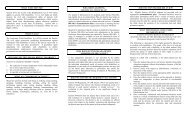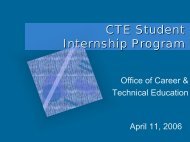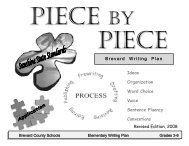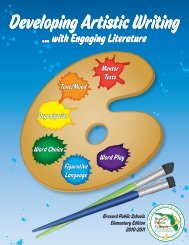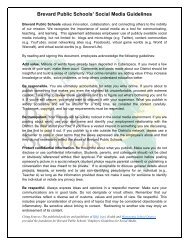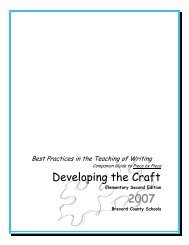2007-08 K-12 Comprehensive Research-Based Reading Plan
2007-08 K-12 Comprehensive Research-Based Reading Plan
2007-08 K-12 Comprehensive Research-Based Reading Plan
You also want an ePaper? Increase the reach of your titles
YUMPU automatically turns print PDFs into web optimized ePapers that Google loves.
extension of the reading block to accelerate student growth. All elementary schools areprovided academic support before or after school for identified students who needadditional literacy instruction.2.3. How will your district assure that the offerings in addition to your CCRP(s),Supplemental Intervention <strong>Reading</strong> Program(s), and <strong>Comprehensive</strong> Intervention<strong>Reading</strong> Program(s) introduce and increase the amount of complex text provided foryour students? If additional exposure to complex text is needed, how will this beaddressed?Teachers utilize Macmillan/McGraw-Hill Treasures Time for Kids articles, whichprovide an enriching exposure to nonfiction and real-world literature. The pairedselection element of the core reading program pairs an informational text with aliterature text around a central theme providing a balance of literature andinformational text within their weekly plan. Students make text-based comparisons andconnections and synthesize information providing evidentiary support from both texts.Teachers are encouraged to incorporate their science or social studies leveled readersas way to differentiate and to stretch their students during small group instruction.Through grant funds, some schools have updated classroom libraries to includerigorous and relevant titles, which support NGSSS and the Common Core StateStandards.Involvement of classroom teachers, media specialists and parents help to guide ourstudents to appropriate reading selections. Common Core Text Exemplars provide asample of appropriate grade level text with complex language, structure and content.Teachers and media specialists will refer to the Common Core Text Exemplars as theytransition from solely matching students to text to selecting text for their instructionalpurpose. A district priority for the upcoming reading adoption is to select a program,which provides a wide range and quality of complex text. As we move forward withCommon Core State Standards implementation, teachers will be provided training onhow to use complex text for close reading purposes as well as enriching Read Aloudsand small group instructional time through utilizing complex text.Brevard Public Schools has a history of utilizing Lexiles to assist in matching studentsto text. Using FAIR (Florida Assessments for Instruction in <strong>Reading</strong>) or SRI (Scholastic<strong>Reading</strong> Inventory) data, students set growth goals throughout the school year toincrease their Lexile score, which motivates students to read more, as well as morecomplex, text. An integral part of the Scholastic <strong>Reading</strong> Inventory is the InterestInventory that each student takes as part of the test. At the end of each assessment, eachstudent will be provided with a list of books that are targeted to his interest and Lexilelevel. We also encourage teachers to look beyond lexiles, the quantitative measure oftext. Text may be more complex and have a lower Lexile on account of the shades orlevels of meaning within a text, the language or structures within the text or the priorknowledge the reader must have to understand the meaning of the text. The mediaspecialist and teacher will play an integral role in helping our students find readingmaterials that will be motivating and challenging at a variety of reading levels andcomplexities based on the required task of reader.Student reading development is enhanced and reinforced through easy, frequent, openand flexible access, to classroom libraries and to the school media center. <strong>Research</strong>14 | P a g e








